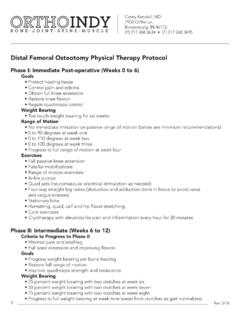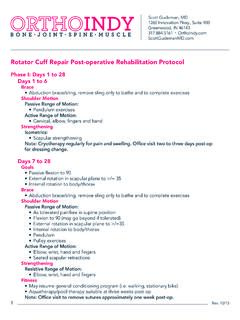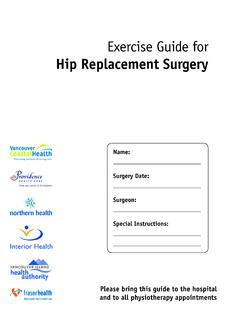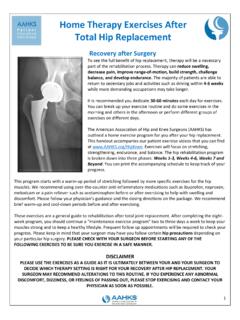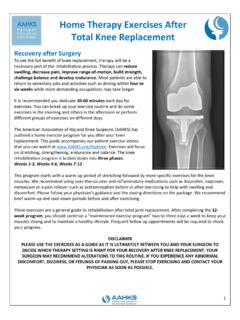Transcription of Exercise Program Before Total Knee Replacement Surgery
1 Pre-habilitation Exercise Program Before Total knee Replacement Surgery Getting Today! One of the keys to a successful outcome after Surgery is beginning an Exercise Program Before Surgery . This gives you a head start on strength and flexibility and improves circulation. The following exercises have been developed specifically for joint Replacement patients and should be done two to three times a day. They are similar to exercises you will do after Surgery , unless your surgeon provides you with a different Exercise plan. Most of these exercises do not require any special equipment and can be done standing, lying in bed, on a couch or sitting in a chair.
2 For exercises that do require special equipment, such as Therabands, visit Any exercises that cause additional leg, knee or back pain should either be adjusted or discontinued. To watch a video with all of the exercises, visit To Begin: Start with 10 repetitions of each Exercise . Gradually increase this by one to two repetitions each day as tolerated until you can perform a Total of 20 to 30 repetitions of each Exercise . Continue with 20 to 30 repetitions of each Exercise until your Surgery . Take short rest periods between exercises if needed (one to two minutes). Use slow, steady movements while exercising.
3 Take slow deep breaths while exercising. Breathe out during the most difficult part of the Exercise . Counting your repetitions out loud can help you remember to breathe. Do not over-exert yourself. Over-exerting is when you are not able to carry on a conversation while doing the Exercise . Do not Exercise in a cold room. There may be a limit to the movement available in your arthritic joint while exercising Before Surgery . This limitation is signaled by pain, so stay within the limits of your pain tolerance. You may start with just a few repetitions, modify the Exercise or stop doing it altogether if pain continues.
4 2 | Total knee Replacement Pre-operative Upper Extremity Exercises These exercises are designed to improve the strength of your arms and upper trunk muscles. You will use these muscles when using a walker or crutches to get around. 1. Thera-band Exercise : Tie a knot in the Thera-band about five inches from the end. Put the knot in the door jam and close the door. Stand facing the door with your arm bent. Keeping your upper arm straight, pull the band back with a slow controlled motion. Hold five seconds and then release back towards the door slowly with control. Do not let the band snap back during this Exercise .
5 Complete the same amount of repetitions on the other arm. 2. Soup Can Exercise : Lie on your back. Hold a soup can in one hand. Bend your elbow and bring the soup can toward your shoulder. Hold for five seconds and then slowly straighten your arm out completely. Complete the same amount of repetitions on the other arm. Pre-habilitation | 3. Pre-operative Upper Extremity Exercises (Continued). 3. Chair Push Up: Sit on a sturdy chair with arms. Grasp the arms of the chair. Push down on the chair arms, straightening your elbows so that you raise your buttocks off the seat of the chair. Hold for five seconds.
6 Lower yourself slowly back into the chair. If your arms are weak at first, use your legs to help raise your buttocks off the chair. 4 | Total knee Replacement Pre-operative Lower Extremity Exercises These exercises are designed to improve your strength while maintaining the mobility of your legs as you prepare for Surgery . They may also be used to improve the strength and mobility of your operated knee following Surgery . 1. Ankle Pumps: Move your feet up and down pulling your toes up toward your shin. Then point your toes downward as far as possible. Complete repetitions for both ankles.
7 2. Ankle Circles: Move your foot around in circles clockwise, then counter-clockwise. Complete repetitions for both ankles. Pre-habilitation | 5. Pre-operative Lower Extermity Exercises (Continued). 3. Quad Sets: Tighten your thigh (quadricep) muscles, pressing the back of your knee down into the bed. Hold this contraction for a count of five and then relax. It is important for you to see the knee cap glide up and down during this Exercise . This indicates you are using the correct muscle. You may prefer to sit up during this Exercise to see this movement. 4. Straight Leg Raises: Bend the uninvolved knee and plant your foot flat on the bed.
8 Do a quad set with the involved leg to keep it straight. Raise the involved leg off the bed, bringing the leg to the level of your bent knee . Gently lower your leg to the bed maintaining a straight knee . 6 | Total knee Replacement 5. Heel Slides: While lying flat on your back on your bed, slide your foot up toward your hip as much as possible, hold for about five seconds, then slide your foot back down. Try wearing socks and using a plastic bag on the bed so your heel slides easily. 6. Gluteal Sets: Squeeze buttocks together. Hold for five seconds and relax. Additional activities you may do Before and after Surgery to improve your strength and flexibility without placing too much stress on your joints include: Riding a stationary bike with the seat high and resistance light, up to 30 minutes a day.
9 Swimming to strengthen and tone the muscles. Walking to increase your endurance. Water aerobics. If you have severe medical problems, such as significant lung or heart disease, please check with your physician Before beginning biking or swimming. If you notice chest pain, dizziness or excessive perspiration while exercising, stop exercising and contact your physician. To learn more about healthy lifestyle changes and warm water Exercise programs in your area, contact the Indiana Chapter of the Arthritis Foundation at Pre-habilitation | 7. Rev. 12/20.
